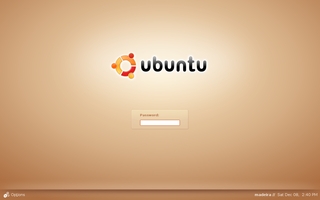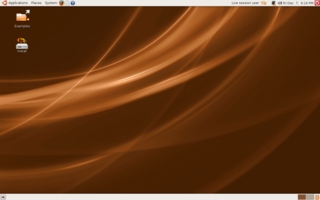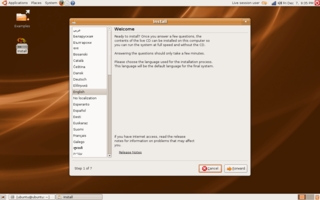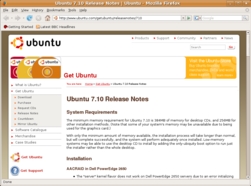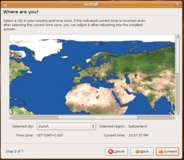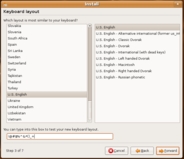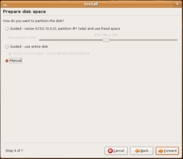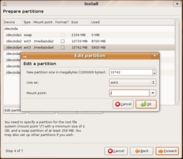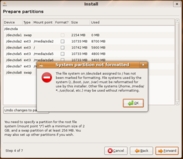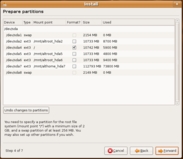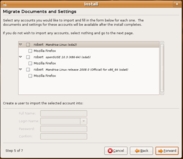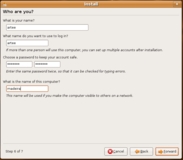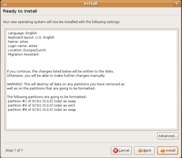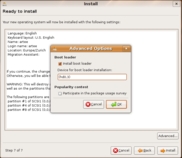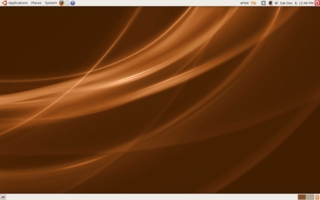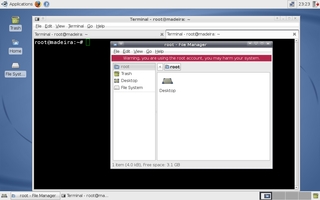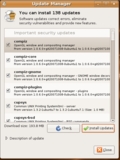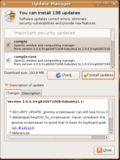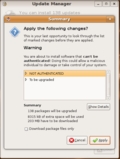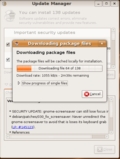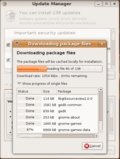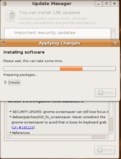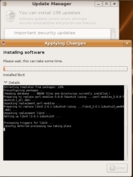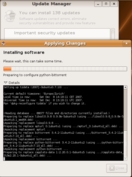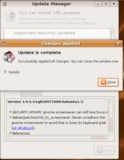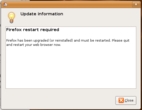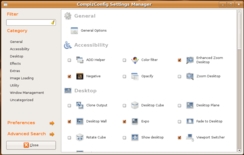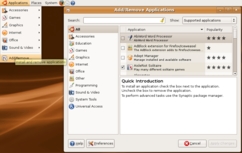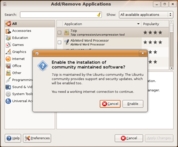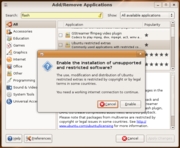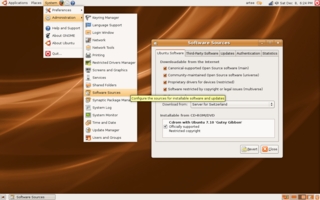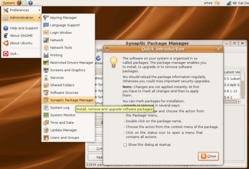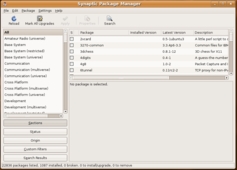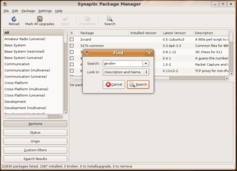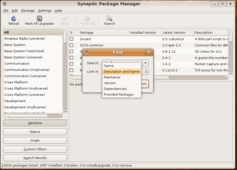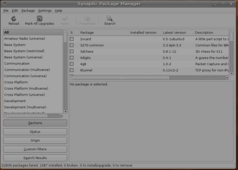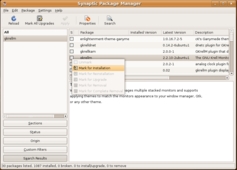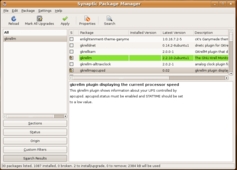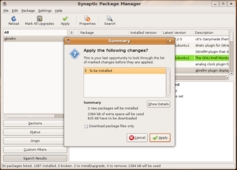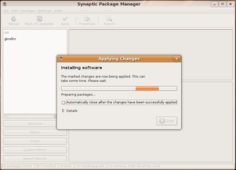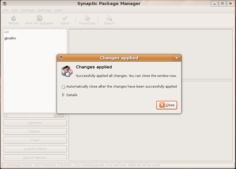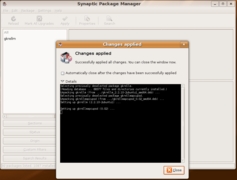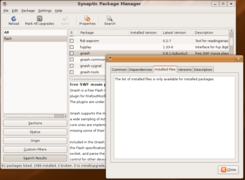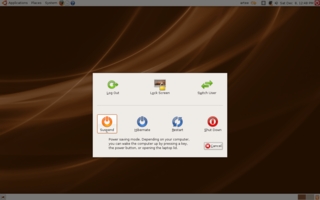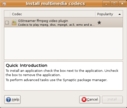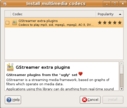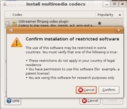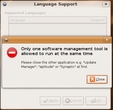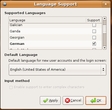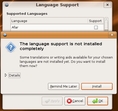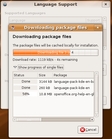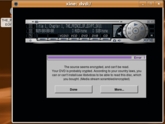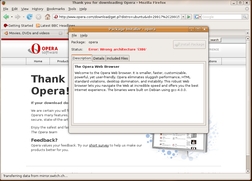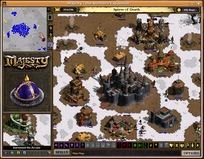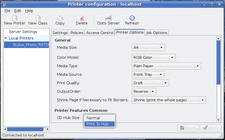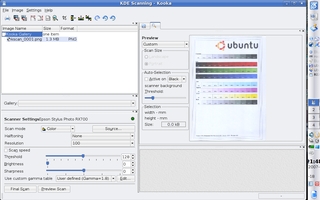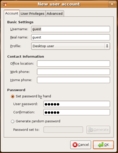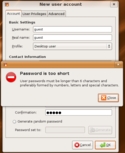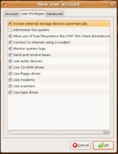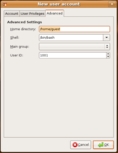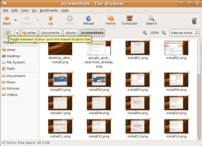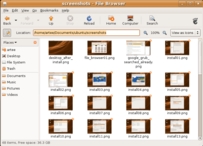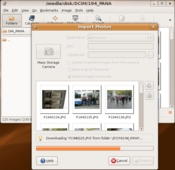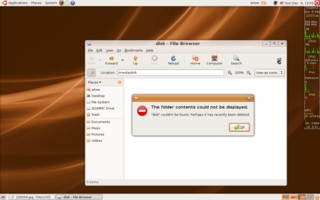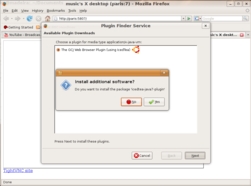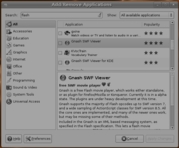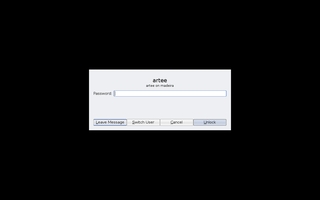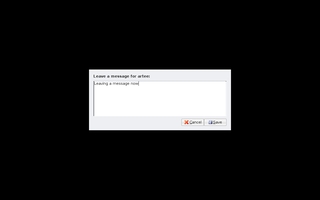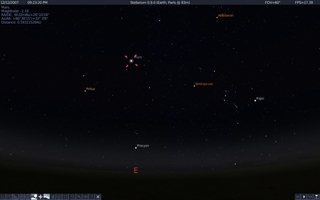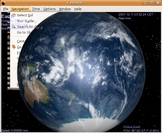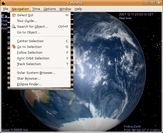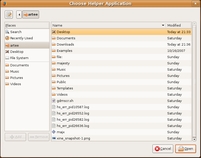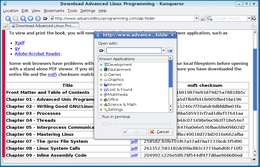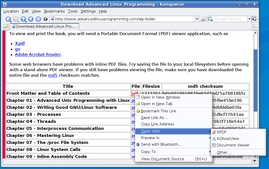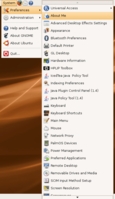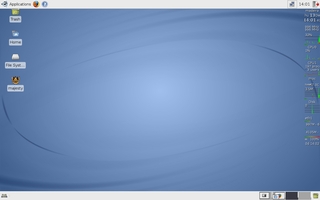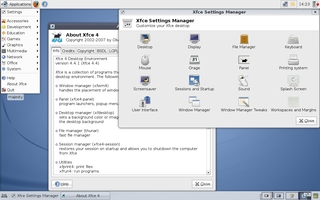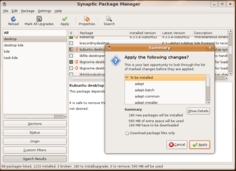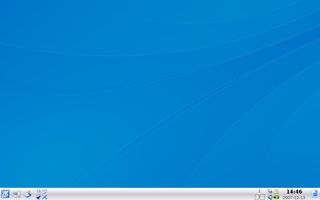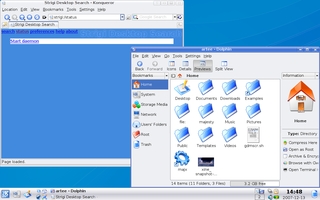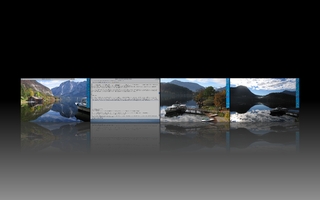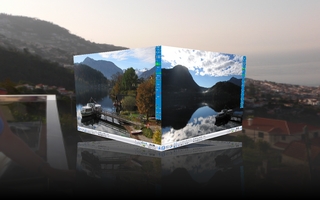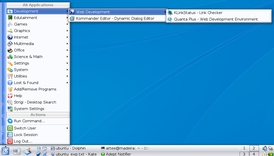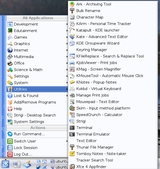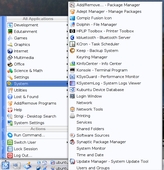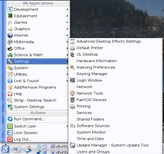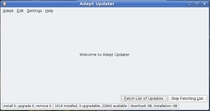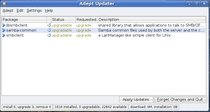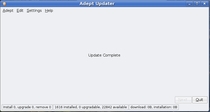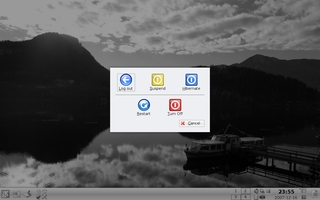Ubuntu — Beyond the Hype
A sidestep to (K/X/)Ubuntu
Related links
Ubuntu main site
Download Ubuntu
Ubuntu forums overview page
Ubuntu English language forums
Ubuntu documentation
Information on multimedia
Ubuntu and Playing DVDs
Site news
Latest site additions:
Updated January 13rd 2008:
My LIRC page: The Linux Audio Server Project - Revisited
Added January 3rd 2008:
My (K/X/)Ubuntu review: Ubuntu - beyond the hype
Added December 2nd 2007:
My Mandriva 2008.0 review
Added November 20th 2007:
The configuration page of Mandriva Linux 2008.0
Added November 18th 2007:
The Installation walkthrough of Mandriva Linux 2008.0
Added November 17th 2007:
The review of openSUSE 10.3
Added July 8th 2007:
The Configuration page of Mandriva Linux 2007.1 Spring
Added July 1st 2007:
The Installation walkthrough of Mandriva Linux 2007.1 Spring
Added December 18th 2005:
The third and final part of my Mandriva Linux 2006 review
Added November 14th 2005:
The second part of my Mandriva Linux 2006 review
Added November 6th 2005:
The first part of my Mandriva Linux 2006 review
For older additions please see the articles page.
Introduction
Since a few years, Ubuntu has been grabbing headlines in the mainstream press, sometimes to the point where people are referring to Ubuntu where they mean Linux (or GNU/Linux as the case may be)...
Ubuntu (and alongside it, though in a lesser way, its derivatives or siblings Kubuntu, Edubuntu and Xubuntu) has been heralded by many as The One Distribution To Rule Them All, One Distribution to bring them all and in the darkness ... Ehh, that's another story.
But the truth is, Ubuntu has indeed been brought forward in many a discussion about Linux for the masses, often proposed as 'the first Linux distribution to get things right' and similar claims. In many talks about malfunctioning and misbehaving Linux systems, Ubuntu proponents are known to have come up with the argument: "well, you should have used Ubuntu instead, because Ubuntu just works"...
All users of any other distribution have seen this, myself included. We've seen Ubuntu proponents diss our own distribution (doesn't matter which one that is). We've seen the claims being made that Ubuntu is the first to get right what any other distribution "has not gotten right yet", whereas we sometimes know that this is incorrect. We've read the comments how Ubuntu is ready for the masses where all other distributions are not there yet.
In short, we've seen and read the hype.
This is not the first time I had a look at Ubuntu, not at all. The first time I tried it, which must be about 3 years ago now, I was curious to see if it was really that much better than other distributions I have experience with. Linux for Human beings, it was said. (More or less implying that other distributions are not, which you might take as derogative... On second thought, I actually agree. The other Linux distributions I used so far are all for computers. I'm not even sure with 'Humans' where to insert the Ubuntu disc, a Flash USB key as some other distributions deliver would be so much more convenient...) Community, it was said. Easy for beginners (which I wasn't anymore at that time), it was said. The One Linux That Just Works (TM), it was said.
Talk is cheap, is also said. And alas, I found that to be true.
To be more explicit: I put Ubuntu to the test at that time, and it failed miserably. It had problems where other distributions had none. One laptop wouldn't even boot the disc, though it worked fine with SuSE, Gentoo, Mandriva (or was it still Mandrake in those days?), and even, of all other distributions, Debian...
Many things that were so heralded, such as easy-to-use and intuitive GUIs, were not so intuitive, hard to use, or even absent, where other distributions did have well working solutions. Hardware detection was nothing better than what other Linux distributions had to offer, namely: a hit and miss track record all around. Nothing magically better. In some cases, sure, somewhat better; in others: clearly worse.
Some had asked me to write a review at that time, which I didn't. To be honest, I like Linux in general, and I'm much less of a "my distribution is the best" type of person than this website URL might lead you to believe. And in that light, you may understand my reasoning not to write a review about Ubuntu was simply because it would have been very negative. I don't care about the flames I'd get from fanbois. It sure would have given Linux detractors a lot to work with: "see, even Ubuntu, supposedly the best Linux, is not good enough, Linux just doesn't cut it".
But it did and it does, at least, at my place. And at many other places, where others, perhaps like me, find it worth it to invest the effort to make Linux cut it. With enough determination, Linux, as an Operating System (so that's really GNU/Linux in this case), has been able to cut it for over 10 years. As a platform (for instance: OOo/KDE/X/GNU/Linux), for over 5, give or take a little, and depending on the (non-mainstream) needs of the user.
But Ubuntu, for all that the claims promised, was so disappointing and I disliked using it so much that I wasn't able to use it long enough to write a decent review. Well, I could have written the review itself, but it wouldn't have been just... I can't write about a system I don't really use. I didn't feel like taking the time to fix the many issues with my Ubuntu system since I had several other fully functional Linux systems. I found Ubuntu was quite far from the linux utopia that was promised by all those claims, much further than some other systems (the ones that I did write reviews about). If you want to slam me, slam me for self-censorship, but please don't tell me at that point in time Ubuntu was living up to much of the hype.
Aside the technical issues I found with Ubuntu, it seemed that the community/communities around Ubuntu was also not as mature as others; due to the openness to new Linux users, the Ubuntu communities showed strong potential, but considering the many threads that just showed willingness to help but lack of know-how to really do so, more progress was still required.
What I realised is that most people claiming baseless things don't really have a clue about other Linux distributions, generalise from their own samples (usually of one), astro-turf or whatever.
And that was quite possibly just a very vocal minority.
Skipping forward to the present, many things have changed. Except for all the claims, which are still firmly in place - just read the web and you'll see. I decided yet again (I had looked at several Ubuntu releases since then, some obtained via ShipIt, most just downloaded myself) to give Ubuntu a good look. And I must say, though many (often as baseless as they are bold) claims are still repeated all around, Ubuntu has come a long way. Perhaps there's a strong self-fulfilling prophecy going on. With lots of users flocking to Ubuntu, the userbase has really taken off. Maybe some of the Debian crowd has decided to take things easier; though jokingly it's been said that Ubuntu is an old African word which means: "I can't configure Debian", I can certainly see the point in moving to Ubuntu if that's what you're recommending to others (Debian is, according to colleagues who use it, not for the faint of heart but all the same, they'll never change - until they change to Ubuntu).
The ubuntu forums I have checked out are filled with useful comments, and the wikis and other kind of websites are likewise full with useful information, not just about Ubuntu and derivatives, but also Linux in general. I'd be way overstating facts in saying that the online Ubuntu information approaches the Gentoo stuff in terms of helpfulness for in-depth Linux hacking and the like, but today there's surely much more substance to at least some of the claims: Ubuntu is easy to install, easy to use, easy to manage.
Whether it's better than other distributions in a straight comparison is something for another review (sometime soon if I can help it), but that's not, nor has it ever been, the point I'll be making. But whether it's functional, usable, yes even pleasant to use, that's the thing. Hint nr. 1: I'm using it right now, and I have for a few weeks now. Want to know more? Read on!
Enjoy,
aRTee
Please note: all screenshots are clickable for a larger version, and more importantly, they all have (somewhat) explanatory titles, which will show up when you position the mouse pointer over them.
Software used for testing
Since Ubuntu (Gutsy, 7.10) can be easily converted into Kubuntu (and perhaps also Xubuntu and Edubuntu, which hold no special interest for me), I opted to go for the 'regular' system, even though I have left GNOME behind some 4 or 5 years ago. I did so due to configuration issues and after some discussions about configuration even more due to "you only need what we offer and if you think otherwise it's because you don't know how to use your computer"-issues. To be more precise, metacity replaced sawfish and I really didn't feel at home; after trying to get metacity to behave for a week or two, I found that kwin did what I wanted within about 3 clicks, so I was a KDE user from then on and instantly fell in love with the configurability,... the colours were certainly a bit harder on the eyes in the beginning... sort of from Vermeer or Dali to Picasso or Mondriaan, or if you really don't like default KDE colours: from B&O to MyFirstSony.
Ubuntu comes in 2 'flavours' for me to choose from: i386 (32 bit) and AMD64 (64 bit). I decided to go for the AMD64 version, since that's what I've been running mostly on the target machine, and it's what gets me the best performance.
Then I had to decide: use the live CD or the alternative cd. I had read that the alternative disc offers more options - which I would need since I had a bootloader in my MBR from 1 of 4 systems, and use that to chainload the other 3 bootloaders in their respective root partition. The liveCD, I was told, would overwrite my current MBR bootloader. I had a look at the alternative cd, but it had a text based installer (welcome to the world of Debian? Very 90's in any case...) and I decided to just do a backup of my own MBR (just in case) and use the live CD.
It would give me the same experience that beginners would have: installing a Linux system with bootloader in the MBR, without having to take into account any other Linux systems, since they have none. Except that I didn't have to partition my drive (it's already prepared to host not one, not two, not three, should I go on yes I will, but Four linux systems). I have found this unfortunate truth: most (new) Linux users don't take into account that they _will_ be installing another Linux system when they first partition their drive to make space for Linux, so they make only the three 'required' partitions: one for the system (/ or root), on for the user data (/home) and the (more or less - one could use a file) obligatory swap partition. I always recommend a second partition for that future system (/mnt/altroot or whatever); in my own case, I have 4 partitions that can serve as system partition. One of those was to be the target of the new Ubuntu. And I'd fix my old bootloader afterwards, if so desired.
Hardware used for testing
The target machine was my trusted laptop, though branded completely differently in fact an MSI Megabook S262. It has an Intel Core 2 Duo T7200 cpu, Intel Integrated graphics (GMA950, 945gm) and Intel IPW3945 802.11 a, b & g WLAN for wireless ethernet connectivity. It's a 12 inch machine, with a 1280x800 screen, four special (semi-)programmable buttons (alongside the on/off button); one of these toggles the wifi and bluetooth radios on and off (it cycles through the following combinations: wlan off, bt off; wlan on, bt off; wlan off, bt on; wlan on, bt on). There's a SD/MMC/MS card reader built in, a dvd+/-rw burner, three USB2.0 hispeed ports, a VGA port, firewire, gigabit ethernet, analog modem, audio headphone and mic connectors (no onboard mic, onboard speakers hardly worth mentioning — but for a 12 inch acceptable). It has a two-hardware button touch pad which has a scroll zone on the right (not marked, it took me some time to figure out it could let me scroll like that) and next to left click it also detects middle click, if tapped with two fingers at once — very nice due to the missing middle 'mouse' button, and it took me some more time to figure that out. It actually sends a right click event if tapped with three fingers — that took me even more time to figure out. Oh, BTW, this laptop was preinstalled with SUSE Linux and it is Novell Linux Certified hardware, and as a cherry on the cream on the icing on the cake, the exact same version with Windows was about 200USD more expensive.
Installation
Installing a system from a Live CD is usually a swift deal, with Ubuntu this was no different.
The live CD had no issues, it booted into the system without any problem, graphics were working fine with Compiz-Fusion activated - though with very mild effects, nothing too flashy. It even got the wifi (which needs the Intel ipw3945d proprietary daemon and the firmware) going by using DHCP for IP configuration. I normally use static configuration, but in this case I figured I could live with a different IP address in my home range until after the installation.
The desktop looked clean and nice, a bit uncommon with all these brown-orange tints but not unpleasing. The installation was short and painless, with a pleasant surprise in the end: a small "advanced options" button, which offered the option of bootloader placement! I was somewhat familiar with GRUB disk numbering, so it was easy for me to figure out that partition 4 on the first harddrive should be hda(0,3). I later found that this indeed had the desired effect.
The system installation is mostly a copy to the harddrive, but after the copying to disk procedure, many configuration things were going on, including configuration of software repositories, all without any interaction on my part.
The installer showed very clear messages, for instance at the very end, the hint that one should take out the cd. When ok-ing to reboot, during shutdown, the cd is also ejected and one has to press the enter key to continue shutting down/rebooting, just to make sure one is not booting into the live cd again.
Better to be safe than sorry, or perhaps: better to be redundant than too quiet and leaving users in the dark.
Booting into the installed system
The first boot into the installed system held some things in store that I found remarkable.
First, after chainloading the Ubuntu GRUB bootloader, I noticed it's a non-graphical bootloader. If you're the type who goes for looks, just hit enter really fast and you'll get rid of the text interface. Luckily I didn't before having a better look around: all 3 other systems (all Linux) on this machine had been added to the menu. Very nice! And to top that off, there was also an entry of memtest86+ (which was also on the live CD boot menu).
After starting the default entry by hitting 'enter', the graphical boot screen of Ubuntu showed up, in the same trusted colour scheme. There's a progress bar, but apparently no way to get to see more details about what the system is doing.
The sparse login screen shows only the text box for the username, a menu at left bottom and the machine name and time at the right bottom side. After entering the user name, one gets to put a password in a second screen. IMHO sparse is good! I don't care much for the 'username-only' followed by the 'password-only' input ideas, but it does make it unambiguous that one can use the enter key after typing in the username.
Upon logging in, I got some messages about updated packages and wireless, which were overlapping, so I couldn't read one of those... since otherwise the system didn't implode, I guess it was of minor importance.
The desktop is clean! No icons, nothing. Very nice!
I checked and found that Suspend to RAM and Disk worked fine, as did CPU frequency throttling. Upon disconnecting the power plug, the system nicely informed me about it, and it gave remaining battery operational time estimations as well.
Configuration
For some reason, the wifi configuration caused me some problems, but only in the beginning. I wanted a static address, which I could choose, but then it didn't connect. For some time I used a dynamic address, then became root to fiddle about a bit and see if I could reconfig to my desired static ip (which I could), and at some point I somehow managed to get the wifi going with my static address by using the GUI. I must have messed up in the very beginning or run into some bug...
In any case, using the GUI the configuration of a network device, in my case my wireless interface, was not too hard. I did a manual setup to avoid connection to neighbours' networks.
BTW 'sudo bash' or 'sudo su' followed by the user password gets me a nice root prompt, no idea why people are so against sudo... ;-)
Perhaps the outcries are about that you can't normally log in graphically as root. I can say that with a bit of messing about, it's easy to get a session going as root, if you know how. Kids, don't try this at home:
In the few discussions where I expressed my ideas about graphical login as root (which are: "just don't"), I had the argument thrown at me: "well, I thought Linux was so flexible, with claims it won't prescribe how I have to work, I should be able to tell it what to do and it has to do _my_ bidding, ... now you're telling me it's not really true, I have to follow some proper way which is unknown to me and which I can't guess..." Well, you could try to guess what the proper way is after finding you're not able to, but anyhow, with some people you can't win, so there now, it's doable, even on Ubuntu. By the time you figure out how, I'm sure you don't need to actually do it anymore. It's a catch 22 so to say...
On with things... The system told me there were updates available: 138. After telling it I wanted those updates, I was informed of some signature issues (this happened on later occasions too, but not always; somehow something went wrong with key importing or so); I continued anyway, as, I think, most would.
After updating, another 6 packages were newly available; I also had those updated. Related to those updates, I was told to restart FF. All in all, a very easy way to get the whole machine up to date.
Note: at some later point, the updates included an updated version of the kernel, after which I got the information that the system needed a full reboot.
As 3D accelleration was working out of the box, with Compiz-Fusion turned on using relatively sober settings, I wanted to configure it a bit more, but didn't find the configurator on the menus, so I decided to see if I could start it from the command line. Naturally I did find a terminal program on the menu, in which I did:
$ ccsm
to which the system stayed silent for a second or two, then said:
The program 'ccsm' is currently not installed. You can install it by typing:
sudo apt-get install compizconfig-settings-manager
bash: ccsm: command not found
Excellent! So I only had to copy paste (lmb select, mmb to paste) the proposed command to get ccsm installed! This is very nice, though on typos it takes a bit of time for the prompt to return, I guess there's always a price to pay. And it never hurts to check what command you're entering.
For some strange reason, by default there are two graphical programs to install software: Add/Remove (on the Applications menu) and Synaptic Package Manager (on the System => Administration menu). Neither show file lists or changelogs, but they are fast and easy to use, and they work well. Add/Remove seems to be aimed at novice users, showing popularity scores for the limited amount of applications that it will install for the user, whereas Synaptic offers the full range of available software.
For software repository configuration, I had nothing left to do, the installer took care of making the available software known to the system. I did have a look at the configuration, which also includes updates, and I used Synaptic to install gkrellm in the below screenshot example. In my experience, Synaptic worked fast, feature rich and reliable.
Most special / multimedia keys on my laptop work out of the box: the sound volume lower/higher and mute (Fn + F7,8 and 9 respectively), the sleep button (Fn+F12) and 2 out of 4 special keys next to the power button/key; those two buttons start Evolution and Firefox (they are marked with an envelope and IE symbol respectively), neat! The remaining two buttons are marked with an antenna signal (for wifi and bluetooth; this button doesn't need OS support, it works directly through the motherboard) and a magnifying glass, they both generate 'Unknown key' events in the /var/log/messages file, so even xev would not be able to pick them up. The other 'invisible' button events that I noticed there are from the power plug, there are events for plugging and unplugging. I have no idea what I could use those events for, so I decided not to configure them. I have done so in the past, it's not very complicated, but I don't care right now. The power button, by the way, triggers the logout dialog, with options to switch user, suspend to RAM or Disk and shut down the system.
In youtube there was no video playback; I had to install some kind of flash player for that. I decided to try Gnash to see how it would do and lo and behold, it did fine. See also: https://help.ubuntu.com/7.10/musicvideophotos/C/video.html#video-online
Note that when I got flash playback going, the system installed a bunch of plugins and programs which added mp3 and avi playback capabilities to the system, so in the multimedia sense, practically all was done at that point.
For the system localisation, I added Dutch, German, French, Italian. This was necessary, since at initial installation I could only install one language. I actually hoped/expected this to also add the languages dictionaries for OpenOffice.org, but it didn't, so I had to figure out that for that the myspell-[language code] must be installed.
I used Synaptic for a bunch of things, including xine and mplayer (my two favourite video players). I still needed libdvdcss to get dvd playback, but I couldn't find it in Synaptic.
This page seemed to have the information I wanted: https://help.ubuntu.com/7.10/musicvideophotos/C/video.html
If you would like to play encrypted DVDs (see the legal note above), press Applications → Accessories → Terminal and type the following into the screen which appears, followed by the Return key:
sudo /usr/share/doc/libdvdread3/install-css.sh
Unfortunately, things were not ok, the system returned with this message:
See `config.log' for more details.
But where is that file? It wasn't in the local directory, and I had no idea where to find it. In the end I found the necessary information here: https://help.ubuntu.com/community/RestrictedFormats/PlayingDVDs
sudo apt-get install libdvdread3 libxine1-ffmpeg totem-xine build-essential debhelper fakeroot
sudo /usr/share/doc/libdvdread3/install-css.sh
Once I saw the name I realised it must be the build-essential package that had been missing before... In any case, once I got that package installed, I could manage to build and install libdvdcss. So I was all set, I could now play (and rip, etc) dvd movies.
Next, I tried to get my one closed source game, Majesty, going, but it just didn't want to run. I tried with a desktop icon, and when that didn't work, on the cli. There was quite a confusing command line exchange:
artee@madeira:~$ /home/artee/majesty/majx
bash: /home/artee/majesty/majx: No such file or directory
artee@madeira:~$ file /home/artee/majesty/majx
/home/artee/majesty/majx: ELF 32-bit LSB executable, Intel 80386, version 1 (GNU/Linux), for GNU/Linux 2.0.0, dynamically linked (uses shared libs), stripped
artee@madeira:~$ ldd /home/artee/majesty/majesty
not a dynamic executable
I was baffled and had no clue as to what could be wrong here. I only stumbled upon the real problem because of other things... more about this below...
Continuing on my journey, I had some more programs to install. First of: Camstream, to check my webcam capabilities (it's a pwc Philips webcam, which used to need special fixes for VGA resolution). Nothing special was needed, plug and play, I got VGA resolution out of the box.
Next I wanted to install Opera, Metisse, Glest and Cinelerra, which are all missing from the repositories my system knows about. As the only program of that bunch to really fix/install, I decided to get Opera from the official website, which actually knows about Ubuntu Gutsy. I was in for a load of trouble though, because Opera is a 32 bit binary, which doesn't quite match my 64 bit system - a fact that I didn't know until I did some web searches. I found information on how to get Opera going on 64 bit Ubuntu, amongst other things the recommendation to use the statically linked version. Sure enough, the one Opera.com had selected for me was the dynamically linked .deb package. I had to wade through the ftp mirrors to get to the statically linked .deb package, which I eventually managed to get installed and working. (BTW I didn't actually manage to get flash working in Opera.)
As a side effect, some 32 bit binary compatibility files had been installed - after which Majesty started to work too!
Adding my Epson RX700 printer scanner combination device was a partial straightforward success, partial online find-your-fix mission. Upon connecting and switching the RX700 on, I got a popup for the mmc memory card (asking me: "open in file browser, get photos, do nothing?") and one for the printer. I decided to print a test page after choosing A4 plain paper, draft quality, and it came out fine (for draft quality). This device is very well supported in Linux, also when printing CDs/DVDs (as the screenshot shows, it allows printing all the way to the hub/hole).
On the other hand, to get the scanner going was not as easy. I found and followed up on the necessary information on the web on how to make the scanner work (I had to do: sudo aptitude install libsane-extras sane-utils; sudo sane-find-scanner), after which kooka showed me the device selection dialog. There were no further issues in scanning, as an example I scanned the printer test page.
Note: this device is normally connected to another machine, and I had not gotten around to connecting it until switching to Kubuntu, hence the screenshots; as far as I can tell, this doesn't make any difference for how the system had to be configured to use it.
When adding a new user (which I had to do, only one account was added upon installation), one has to indicate if the new user should get sudo rights (to administer the system), though I'm not used to it, I find this a good way of working. Additionally, I found that a new user password must be at least 6 chars (unless you use sudo passwd [username], in which case you can avoid this check) and there's a nice recommendation about safe passwords.
I added a user, but somehow it didn't show up, so I tried adding the same user again, but then it wouldn't since the user supposedly already existed... Puzzling, but indeed the user was added to the system.
On Ubuntu, users get UIDs from 1000; the live cd user actually has uid 999. There's a feature that should disallow any login with uid below 1000 but I found that with another user with uid 501 I had no trouble to login. All user files are attributed to the same group id number and name. (Meaning for user 'artee', the ownership and group id are both 'artee'.)
Daily use
By default, Ubuntu has Compiz-Fusion turned on (at least, on capable hardware, such as mine), but with default settings that are not too flashy (no wobbly windows or so), even sober, and that are imho well chosen: desktop wall, expo, enhanced zoom desktop, nice selection of window animations, negative, desaturation (discolouring windows of unresponsive applications, I got to see this effect quite often in the beginning, as will become clear shortly). So the really bouncy, flashy stuff was turned off (rain, gears, paper plane animation), as were some not-so-far-out things (scale, cube, reflection on cube, transparent move).
I kept working with the defaults for quite a while, it was a usable, pleasant setup.
The file browser has a nice option for path names or buttons, so to each his own. The spacial browser thing seems to be a thing of the past at least in terms of what the user gets by default (I never liked it myself, so I was happy I didn't have to fiddle with the system to turn it off). One thing that did strike me as odd (should I say: weird and confusing?) was that html text files were supposedly executable (no, it was a regular rw-rw-r-- file)...
Out of the box, both Suspend to RAM and Disk worked fine, but whilst doing a Suspend to Disk/Hibernate, the system shows some unintelligible messages (non-graphical) about the USB subsystem or so. The wake-up from Hibernate is not automatic, meaning that one gets the grub menu and could choose a different option. This might be problematic if the machine has several different Linux systems that share the swap partition, which at that point holds the suspend to disk information, and one chooses to boot another system (for instance just forgetting the system was not shut down but suspended). After choosing the default system in the non-graphical boot menu, the regular boot progress image is shown, but the progress indicator 'stops' at a few percent. The disk activity LED shows things are in motion, but the impatient, less confident, might assume the system is hanging and force a reboot. Which would be a shame since Hibernation works well, but obviously, not clear. The system also informs the user that Hibernation didn't work, after properly going to sleep and waking up without any issue...
Wifi usually works fine after suspend to disk/RAM, but sometimes I had no more wifi connection after resuming, that is, not directly. Doing the setup again would fix htings, but some patience also helps. As long as I was in roaming mode, I needed to input my wpa key again, but often this dialog box popped up behind some other window... so the user would have to find it first!
Other popups also pop under instead, maybe this is a compiz issue..? Since Compiz-Fusion is the default, it is still an Ubuntu issue.
Talking about the wireless, it would sometimes fail to connect or lose the connection. This happened irregularly and not too often, but it's something that could be better. Note that this may be related to the functionality of the proprietary daemon, meaning that Intel has to fix this, the Linux developers can't help it since they don't have the source code of all the parts. The new iwl3945 driver that is to replace the ipw3945 at some point doesn't need a proprietary daemon, and as soon as it's a fully functional replacement I expect all Linux distributions to switch to that one by default.
Staying with wireless, but then another kind: I had no problem to connect to my phone with Bluetooth.
My built-in 3-in-1 cardreader works fine with SD and MMC cards (MemorySticks don't work, perhaps they never will, the only thing on my laptop that's non-functional under Linux):
"Unmount volume" is not as easy to understand as "safely remove", but it may be understandable enough. On the other hand, if one removes a card without unmounting, it is mentioned with a popup that one should first 'safely remove'...
Some programs were not on the menu anywhere. For instance gkrellm and vncviewer. The latter was realvnc (as opposed to tightvnc which other distributions often come with) and it had a nasty issue with its password dialog box, which usually needs convincing before allowing to enter anything. I could click a few times inside the text box, but just wouldn't get a cursor. Very strange. (Tightvnc lets the user input the password from within the terminal window if lauched from there, so no extra password popup is used.)
To connect to a vnc server, there's also the option of using a java enabled webbrowser. The java viewer didn't work in Firefox, and it took me quite some effort to manage in Konqueror; in the end I had three different versions installed, one from Synaptic which I found when searching for java (blackdown?), and another when trying to get FF to work with Java by clicking the 'click here to install missing plugin' (that was icedtea I think), and the last was Sun Java 32 bit version found in Synaptic when searching for 'Sun'. That one finally worked, after a bit of fiddling (and it takes a good long time to start with a vnc java viewer session, minute or so).
And now for the most annoying thing, usually manifesting itself through applications that suddenly get the desaturation effect, indicating an unresponsive program...
Sometimes the system would experience a full lock, no gkrellm updates, nothing. I had some experience with this behaviour before, it's really quite bad and can easily take up to a minute or more; enough to give the impression that the system is really totally dead. (The system messages at /var/log/messages show ata problems, one of which is: "ata1: port is slow to respond, please be patient (Status 0xd0)") The workaround I've found and used is to do "killall hald-addon-storage". This gets rid of the locking and the only negative side effect is that upon disc insertion into the dvd/cd drive, nothing will happen. So one has to start the file browser or dvd playback program or whatever, by hand. No big deal. Especially compared to the system locking.
The Live CD didn't have this problem, most likely because the optical drive was in use...
I added the killall command to /etc/rc.local, because I tended to forget to issue the command, in which case the system would remind me by locking up for a minute or more, forcing me to wait it out until I could quickly go in and kill the offending process.
This problem is due to a firmware issue with TSST optical drives, and it doesn't show up with the older ATA driver (which shows ata / ide drives as /dev/hdx) but it does with the new libata driver (which shows ata/ide drives as /dev/sdx). Information on the web hints that even Windows is affected, though not in the same way, and TSST (Toshiba Samsung Storage Technologies) have made new firmwares available for affected models - though with only a method for flashing under Windows, which I don't have... I know there's a workaround involving 2 usb sticks and some dos commands, but I'll take that bridge if I really have to, not before. Perhaps I can contact the vendor about this, my laptop is a Linux preinstalled machine, Novell Certified as well...
User switching works well, but within limited scope: via the logout/off button: a new X session is created and the session of the previous user is locked. I found out that direct switching back and forth with ctrl-alt-F[7-12] (which GNOME doesn't mention, contrary to KDE) doesn't lock the screen (which I didn't expect). The switch button on the screenlock and logout dialogs will not switch to existing users; one must use the panel switcher for that. This may lead to the situation where user A is logged on, user B switches and logs on to his new desktop, then the system is switched back to user A, who then locks his desktop. So how can B get back to his desktop?
Another remark about user switching: the second user gets metacity, not compiz. This may be a limitation of Compiz-Fusion or X, combined with my hardware.
The GNOME screenlock offers the option of leaving a message for that user. I find this a very nice touch, for a personal machine not so relevant but for business use an excellent feature - how often does it not happen at work that you try to find someone who's just stepped out (short break, meeting, whatever), and you have to scramble at someone elses desk to leave them a quick note? This solves that problem right there!
After installing kubuntu-desktop the boot progress screen is blueish with Kubuntu in large friendly letters, instead of the orange-brown Ubuntu screen. After I installed the xubuntu-desktop, I still got the Kubuntu boot progress screen, but the xubuntu themed login manager. Ah well...
I installed stellarium, which worked fine:
but there were some problems with displaying due to compiz-fusion. I used fusion-icon (which I installed by compiling; there's no package for Gutsy - it also may not play nice with all types of graphics chips though with my Intel integrated graphics it works as expected) to switch to metacity/kwin temporarily.
The external monitor connection was problematic; I found no way to make it work automatically, or switch it on on the fly - something the new 'intel' driver for this graphics adapter should be capable of. I don't really need it and I'm sure I could get it going, but I did't want to invest more time.
Ubuntu vs Kubuntu vs Xubuntu, or GNOME vs KDE vs XFCE
This section is not exhaustive, nor is it intended to be. I just note some differences that are striking to me; I haven't used GNOME in ages, but the first week or so on Ubuntu I used GNOME exclusively. Only after that period did I install the Kubuntu and Xubuntu desktop systems, mostly to see how those desktop are set up in the ubuntu/debian world. I have not used/seen XFCE in a long time and never used it for extended periods of time. I have not taken the time to do any special configuration, so my comments here (mostly) apply to default settings.
I already described GNOME on the stock Ubuntu installation. It's very usable on the whole, even for a KDE guy like me, though I wouldn't consider it an absolute pleasure per se.
I have some gripes about certain aspects of GNOME, which I will illustrate with the GNOME screenshot application (the worst offender of common sense that I came across), which I used extensively until I had KDE installed (at which point even under GNOME I predominantly used ksnapshot):
- when taking a screenshot with the print-screen key, on the save dialog, one can get the message that the filename already exists, in which case one gets the choice to replace or cancel; no preview, and when doing cancel, one does NOT get the chance to save under a different name...!
- even when starting the 'take screenshot' program from Applications -> Accessories -> Take Screenshot, after the shot the initial program window is gone
- the screenshot proposed name is always Screenshot.png, instead of incrementing the count in the name of the previous file
- the screenshot config is always reset to default (whole screen, 0 secs)
- the screenshot key doesn't work whenever a menu / dialog is open
As I hinted, ksnapshot has none of these issues.
The next comment is about Firefox, not a GNOME program, but on Ubuntu the default web browser, so I want to mention this anyway. (It's most likely true for any Linux system with FF as webbrowser.)
Something that is really annoying, not userfriendly at all - should I say: "userhostile" - and shows bad (absent?) integration: the Firefox dialog "open with", where you get to search your application, good luck browsing through: /bin/ or /usr/bin/ or whereever. Sure, I know I can use 'which [application name]' to get the path, but how do novices know? And that's assuming that you know the application name; what if the user wants to open a pdf reader and doesn't know which ones there are?
On KDE/Kubuntu, Konqueror is so much more userfriendly and better integrated: first off, it shows the various programs that the system knows can deal with the type of file you're trying to open, secondly, the "open with..." dialog shows the menu where you can just pick your application, and also a text field where you can type the name of the application should you know it. I put things to the test, and found that it's enough if the application is in your $PATH. So no long path to figure out, just the application name.
I set up the following different keyboard layouts: us us_int switch, dutch. Using System -> Preference -> Keyboard I had no problem to choose various layouts (limited to 4, why?), it was just puzzling how to select between them. One needs the panel applet "Keyboard Indicator" (it's not just an indicator, it's a selector too). Very nice: the 'Show Current Layout' option from the right click menu. What was confusing to me was the 'per window' option - with my settings it didn't work so well..., if I have a maximised window in the background, and a smaller window in front in which I type, and focus follows mouse, moving to the applet I'll always cross the maximised window, making it impossible to choose the keyboard layout for the application I'm using. I overlooked the 'per window' option, so I had the feeling the system was playing tricks on me for a bit.
The gnome menu sometimes has too much on the same level, mostly because I installed lots of things (most notably kde and xfce), but still, this is not the summit of userfriendlyness.
Other reasons for not finding absolute pleasure in using GNOME/Ubuntu are fully subjective and so not relevant. If you enjoy GNOME/Ubuntu best, great for you.
Xubuntu:
XFCE looks very nice, clean but contrary to GNOME with some icons on the desktop, and it is fast.
I had some problems with Compiz-Fusion on Xubuntu (namely, ctrl-alt-arrowleft/right would switch two instead of just one desktop, meaning: instead of going to the next desktop, it would move to the one after that, so from 1 to 3 to 1 to 3, or 2 to 4 to 2 to 4; so if you happen to have the default 4 desktops, there will be some that you always skip...), but if you're the type who wants a really fast system or decent speed on older hardware, Compiz-Fusion is not likely at the top of your list. XFCE has a configuration panel that is a nice access point to the DEs features. I like the look and feel of the file manager as well.
XFCE is gtk based, and many applications it uses are actually GNOME tools.
Kubuntu:
Back into KDE, Klipper rules!
Dolphin is the default file browser; I'm not convinced this was such a good choice, it's a fairly new application and has quite a few rough edges, and much less functionality than konqueror.
Speaking of which, typing some words into konqueror url field performs a desktop search with 'strigi' (the next upcoming thing in desktop search, supposedly faster than beagle and part of the 'semantic desktop'), instead of a web search with google. At least it does something potentially useful, and there is the google search bar next to it. I personally have no need for strigi/desktop search engines, but it worked ok when I tried it.
Using fusion-icon I turned on Compiz-Fusion, no problem. It seems that when using CF on k/x/ubuntu, the settings from Ubuntu are not kept. When using Compiz-Fusion, the pager on KDE is broken, it shows all windows on the first desktop (most likely because when using compiz-fusion, for KDE they actually _are_).
On the kmenu, the quanta+ entry is really unnecessarily deep.
I found it surprising to see that the menus across the different desktops do not have the same contents at all, nor do they have the same ordering. The Kubuntu menu has lots of redundancy as well.
Kubuntu has a nice power manager which shows the current clock speed of your processor(s) and lets you configure various power saving features.
Kubuntu has the 'best' looking logout transition (wave!) of all three desktops. (Note: with Compiz-Fusion it doesn't look as nice anymore.)
GNOME has the great 'leave message' option at the screenlock. Shame it's not possible to copy the contents of the message (afaict).
gnome-screensaver &
gnome-screensaver-command -a -l
will give you this under kde too...
gnome-screensaver-command --exit
to stop it.
On a side note,
kdesktop_lock --blank --forcelock
gives the kde screenlock. Note that the messaging system from the GNOME screenlock works fine on Kubuntu:
At some point I also got a third software installer (as part of kubuntu-desktop?): Adept Manager. I see no point in yet another software package installer, but apparently it makes people happy. This one had a tray icon that was constantly floating on the desktop, instead of nesting itself neatly into the tray. It worked well enough though, as you can see from the screenshots.
And I 'lost' the functionality that upon pressing the power button, I would get the logout menu. Now the system shuts down immediately, not exactly nice if I'm pressing that button to choose 'suspend' (to RAM, few seconds to wake up again).
Differences on the command line
Using the command line interface a fair bit, I found some interesting differences with other UNIX systems I have used. This, again, is not a complete list by far, it's just a quick rundown of what surprised me.
ll is not aliased to ls -l (common on all HP-UX, Solaris and Linux systems I have used so far); I did realise this is just a very common alias, but I'd have thought Ubuntu and siblings would be among the 'have' crowd and not the 'have nots'...
Similarly, rm is not rm -i, rmdir is not rmdir -i, so no questions asked! If you have experience with a less 'die-hard' setup, with the added safety net of the defaul -i behaviour, this may take some getting used to - the hard way.
Next: vi is not vim, but real vi. Which sucks compared to vim. Also, on Ubuntu, vim has no highlighting (at least by default, and I have no idea how to fix it nor do I want to spend time on figuring it out), for instance when editing xorg.conf or so.
X forwarding is not implicit in ssh connections, the user must run ssh -X [ip] [-l user]
The command history doesn't go back to 'before' the opening of the shell you're in. Big shame. It's a great way to trace back your steps in case of problems ("Well, I don't recall what exactly I did, or in what order"). This also makes for instance ctrl-R much less useful.
Taking a guess, I'd say that these choices are potentially inherited from the base system Debian.
Often in Ubuntu the roots of Debian shine through, sometimes that's great, in this case, IMHO and if I'm not mistaken, it's certainly less optimal. I may be wrong as to the reasons why these things are not set up in a more convenient way. Sure, in the case of rm -i or rm -f it can be argued (it surely must have been...) as to what's proper or more sane, but the history being so limited, common aliases missing and more, is just making things a tad bit less enjoyable, not to say even somewhat annoying or tedious, to use.
Conclusion - beyond the hype
Coming back to the hype, Ubuntu lives up to it only partially (as do Ubuntu's siblings Kubuntu and Xubuntu - I won't be mentioning those explicitly anymore, just fill them in as you please). Whenever it's stated/claimed/implied that Ubuntu is finally the one Linux to take the world, take over the desktop (entice Windows users to take the plunge), where other Linux distributions have failed, I can only say: ehmm, no, not as far as I can tell.
I can honestly not see any major points where Ubuntu outshines the competition, some things are done slightly nicer (often up for debate, depending on taste and whathaveyou), some are slightly less nice.
So after all the hype I guess what remains is this:
Like all Linux distributions I have used so far, Ubuntu does have a few rough edges, dark spots and negative points. Some of these are totally subjective, depending on taste and preference of the user, or subjective in the hardware sense: depending on the hardware, the problem shows up or not.
Some are trivial to fix (don't like GNOME? apt-get install kubuntu-desktop xubuntu desktop), live with (non-graphical boot menu, non-graphical suspend to disk, non-functional progress bar on wake-up from hibernate, non verbose boot messages in graphical boot) or get around (quanta+ to deep in the menu? Drag the icon to the panel/kicker, and you'll never have to get it from the menu anymore).
Some things are somewhat more difficult to manage, especially for novices, such as dvd playback, scanner adding, temporarily turning off Compiz-Fusion to use 3d software such as Stellarium and Celestia (from the cli or with fusion-icon after compiling it).
Or the way to get proper 32 bit compatibility on 64 bit Ubuntu, which leaves a lot to be desired; on other Linux systems it's no problem to use the dynamically linked version, or at least 32 bit statically linked binaries are directly executable. You can surely blame my ignorance in this matter, but then don't claim Ubuntu as the 'linux finally done right for novices'.
And then there are the big problems, where the uninitiated will likely turn their backs to Ubuntu or even Linux in general, such as the locking problem due to the libata driver. Though the workaround is trivial to implement, someone who doesn't know /var/log/messages may give a clue as to what's wrong, will not be able to search for the right terms on the internet, and will thus not find the solution. Note also that the cause of the problem (the faulty firmware of the TSST optical drive) is irrelevant to most users. They just notice Ubuntu / Linux doesn't work properly. Note that TSST has about 20% market share, so it's not like I'm the only one seeing this problem.
On the other hand, like all Linux distributions I have used so far, Ubuntu is a full fledged Linux system. On top of the myriad of software packages, easy installation, up to date hardware support, Ubuntu sports some really great features (such as Synaptic and apt-get, sudo and the whole method of system administration) that it inherits from Debian. It's a very usable if not enjoyable system.
All in all I see Ubuntu as a solid Linux distribution. If it can be done on Linux, it can be done on Ubuntu. As for the hype - allow me to speculate freely, if you don't agree and think this is nonsense, fine - I think perhaps many Debian users have found a new home over the past few years in Ubuntu - based on Debian but with lots more convenience built in and more up to date; some of these users may have been genuinely surprised at the ease with which most things work, and from there to all the hype it only takes a very tiny but vocal minority. From the joke: Ubuntu is an ancient word that means: "I can't configure Debian", perhaps this is closer to what's going on: "I'm in the mood for Debian but with more convenience and more up to date and I don't have as much time".
Speaking of which, my time's up.
This is my third distribution review in the past two months, and I hope you enjoyed it, as it's most likely the last for a long time to come.
Rob Teng a.k.a. aRTee
PS Indeed, my wife was complaining I was spending too much time with "Suse, Mandy, Bunny and Red-Head"... My defense "I don't even use Red Hat! The last time was 4 years ago, honest!" naturally didn't fly.
Discussion
You can discuss this article here.
All contents © copyright 2003 - 2007, unless mentioned otherwise, published under the GNU Free Documentation License (FDL) by aRTee. Artwork and CSS don't fall under the FDL, standard copyright applies. Tux image from Larry Ewing. You may use anything published under the FDL on this site freely, as long as you include this copyright notice and a reference to the main address of this site: www.mandrake.tips.4.free.fr.

